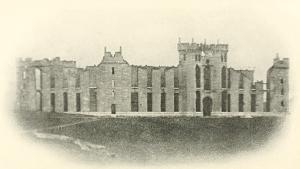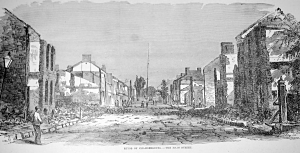
This last of three installments on the Shenandoah Valley during the Civil War shifts to civilians. The frequent presence of United States forces in the Valley exposed civilians to significant disruption of normal routines. Although most white residents embraced the Confederacy with enthusiasm, Unionists—who included African Americans, members of religious sects such as the Mennonites and Dunkers, and part of the yeomanry—often stood at odds with the national administration in Richmond and sometimes suffered harsh treatment from neighbors, governmental officials at all levels, and representatives of the Confederate army. Black people, both enslaved and free, typically welcomed the arrival of Union troops, and many black refugees made their way to northern lines. As Nancy Jenkins Jefferson, who had lived in Augusta County as a free woman before the war, recalled in the 1870s, her loyalty had been “all the time with the Union.”
Military operations in 1864 brought considerable dislocation to the Valley’s economy and people. Lost Cause writers subsequently claimed that Philip H. Sheridan’s army pursued brutal warfare against civilians and their property—and in fact Sheridan’s logistical targeting during “The Burning” in September and October anticipated William Tecumseh Sherman’s “March to the Sea” later in the year (both generals acted under almost identical instructions from U. S. Grant). By Sheridan’s own reckoning, his troops destroyed or captured 3,772 horses, 10,918 cattle, 12,000 sheep, 15,000 hogs, 20,397 tons of hay, 435,802 bushels of wheat, 77,176 bushels of corn, 71 Flour mills, and 1,200 barns. Yet these numbers, however impressive, represented just a fraction of the agricultural capacity of the area, and Union troops usually spared private dwellings. In Rockingham County, for example, which was among the hardest hit sections of the Valley, Sheridan’s soldiers destroyed less than a quarter of the 1860 level of production.
 Whatever the percentage of lost logistical resources, Union operations created feelings of bitterness and, in many cases, despair among Confederate civilians and revealed a hard edge to Federal attitudes. One woman wrote in her diary about northern soldiers who laid waste to her family’s large farm, “the shouts, ribald jokes, awful oaths, demonical laughter of the fiends.” For their part, Sheridan’s men sought revenge for the burning of Chambersburg and the actions of Confederate guerrillas. When the son of Union Quartermaster General Montgomery C. Meigs was killed near Harrisonburg in early October, Sheridan pronounced it an act of bushwhacking (some Federals claimed Confederate civilians perpetrated the murder) and ordered the burning of all property within three miles of where John Rodgers Meigs died.
Whatever the percentage of lost logistical resources, Union operations created feelings of bitterness and, in many cases, despair among Confederate civilians and revealed a hard edge to Federal attitudes. One woman wrote in her diary about northern soldiers who laid waste to her family’s large farm, “the shouts, ribald jokes, awful oaths, demonical laughter of the fiends.” For their part, Sheridan’s men sought revenge for the burning of Chambersburg and the actions of Confederate guerrillas. When the son of Union Quartermaster General Montgomery C. Meigs was killed near Harrisonburg in early October, Sheridan pronounced it an act of bushwhacking (some Federals claimed Confederate civilians perpetrated the murder) and ordered the burning of all property within three miles of where John Rodgers Meigs died.
Mary Greenhow Lee of Winchester left a diary that abounds with information for anyone interested in aspects of civilian life in the Valley. Union and Confederate military forces regularly passed through Winchester, fought several battles within a twenty-mile radius, and sent large numbers of wounded soldiers into the city—all of which prompted comments from Lee. The vagary of life under Union occupation forms a theme through much of her journal, as does the effort by the town’s citizens to keep up a normal routine centered around business affairs, social relations, and religious activities. A number of entries describe the ways in which the institution of slavery weakened under the stress of war. Most obviously, the journal’s many references to lost friends, material and mental hardships, and debilitating uncertainty underscore a profound alteration of peacetime living patterns.
Like most white civilians in the Valley, Mary Greenhow Lee developed a deep animosity toward the Federals. Robert E. Lee’s surrender in April 1865 left her stunned: “Hope is destroyed & I can only pray for strength . . . . I shall have to drag on a weary existence, struggling with dire poverty in a country infested by Yankees, for they will pervade every section like the locusts of Egypt.” Anyone who embraces the idea of easy reconciliation after the war will find no comfort in Lee’s journal. On October 8, 1865, she described a stronger and more united sentiment “against the Yankees than existed a year ago. Old & young men fire with wrath at our present condition & are ready to side with any party who will chastise our tyrannical foe.”
The Nau Center’s 2017 Signature Conference will help attendees appreciate some of the myriad ways in which the Civil War left its mark on the Shenandoah Valley, on residents such as Nancy Jenkins Jefferson and Mary Greenhow Lee, and on thousands of officers and soldiers in Union and Confederate armies. In some ways unique and in others representative of what the war brought to many other areas, the Valley provides a fascinating window into the most turbulent period in American history.
First Image: The ruins of the Virginia Military Institute in 1864 (Wikicommons).
Second Image: “The Ruins of Chambersburg—View of Main Street,” an illustration Harper’s Weekly offered readers three weeks after Jubal Early’s cavalry burned the Pennsylvania city in retaliation for Federal destruction of civilian property in Virginia. Union soldiers often alluded to Chambersburg’s fate in seeking to make citizens in the Valley pay an equivalent price (Harper’s Weekly, August 20, 1864).
